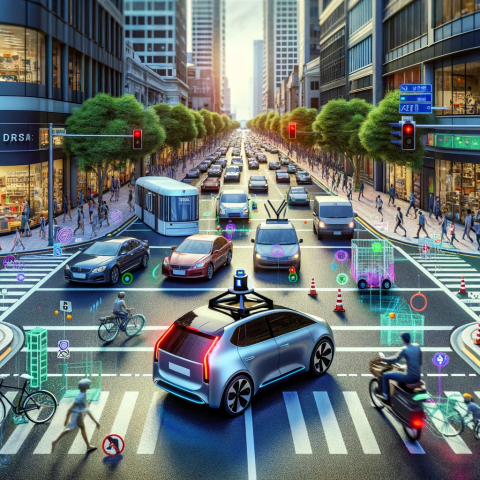Welcome back to our weekly “How To” series of blog posts. This week, we take on Mastering Data Annotation for Autonomous Vehicles with our comprehensive guide. At this point, some of our readers might feel that navigating the world of autonomous vehicles or self-driving cars is like stepping into a sci-fi movie. But behind the scenes, it’s all about data—specifically, data annotation.
So, let’s not waste too much time and jump right into another informative read on the essential guidelines and best practices, chock full of easy-to-understand, bite-sized examples designed to help you master data annotation for AVs and streamline this crucial process.
Understanding the Importance of Data Annotation
When you think about autonomous vehicles, you probably picture sleek cars gliding through city streets without a driver. What you might not realize is that these vehicles rely heavily on meticulously annotated data to interpret their surroundings and make decisions. Data annotation is the backbone of training machine learning models to recognize and respond to real-world objects like pedestrians, traffic lights, and other vehicles. Be sure to check out our most recent posts on Decoding Data Annotation to gain even more understanding.
Getting Started: Setting Clear Objectives
Before you even annotate data, setting clear objectives is critical. What are you trying to achieve with your autonomous vehicle? Are you focusing on urban driving, highway navigation, or perhaps complex environments like construction sites? Defining your goals will guide your annotation strategy, ensuring that the data you collect and annotate aligns perfectly with your end use.
Example: Imagine you’re working on an autonomous delivery vehicle designed for city environments. Your primary goal is to ensure the car can navigate narrow streets and avoid pedestrians. This objective will influence every aspect of your data annotation, from the types of objects you label to the level of detail required.
Here are 5 to consider:
1. Understanding the Environment: City streets are often bustling with activity. Your vehicle needs to recognize a variety of objects, such as cars, bicycles, pedestrians, street signs, traffic lights, and even smaller details like curb edges and road markings.
2. Labeling Objects: Given the complexity of city environments, you’ll need to label a diverse set of objects. For example, you would annotate:
- Vehicles: Cars, buses, trucks, motorcycles, and parked vehicles.
- Pedestrians: Adults, children, individuals with disabilities, and groups of people.
- Infrastructure: Traffic lights, stop signs, crosswalks, road markings, curbs, and barriers.
- Other Elements: Trash bins, construction zones, and any temporary obstacles that might appear.
3. Detail Level: The level of detail in your annotations must be high to ensure the vehicle can make precise decisions. For instance, when labelling a pedestrian, you might need to annotate not just the person but also their limbs and the direction they are facing. This helps the vehicle anticipate its movement.
4. Dynamic Situations: City environments are dynamic, with objects constantly moving. You need to annotate scenarios that reflect this, such as pedestrians walking, bicycles weaving through traffic, and cars making sudden stops.
5. Occlusion and Overlaps: In crowded streets, objects often overlap or are partially obscured. Your annotation guidelines should include instructions on how to handle these cases. For instance, if a pedestrian is partially hidden by a parked car, you should still label the visible parts and infer their likely movement.
Choosing the Right Annotation Tools
With your objectives set, the next step is to select the right annotation tools. There are various tools available, each with its own strengths. Some popular ones include Labelbox, V7 Labs, and CVAT. The key is to choose a tool that offers the flexibility and features you need, such as support for 3D annotation, automated annotation assistance, and effortless collaboration with your team.
Example: Suppose you’re annotating LiDAR data. A tool like CVAT, which supports 3D point cloud annotation, would be ideal. It allows you to accurately label objects in a three-dimensional space, which is crucial for developing robust perception algorithms. Some of the benefits of using the right annotation tools include:
- Accurate Labeling: CVAT provides features to annotate 3D point clouds, allowing you to label objects accurately in a three-dimensional space. This capability is essential for creating precise annotations needed for training perception algorithms in autonomous vehicles.
- Handling Complexity: The tool supports complex annotations, such as defining the boundaries of objects in a cluttered environment or annotating overlapping objects, which is common in LiDAR data.
- Speed and Efficiency: CVAT offers automated annotation tools that can significantly speed up the labelling process. For example, it can automatically generate bounding boxes for detected objects, which annotators can then refine.
- Reducing Human Error: Automated assistance helps reduce human error by providing a first-pass annotation that annotators can adjust, ensuring consistency and accuracy.
- Seamless Workflow Integration: CVAT integrates well with various machine learning frameworks, allowing you to export annotations in formats compatible with your training models.
- Flexible Export: The tool supports multiple export options, ensuring you can easily incorporate the annotated data into your existing workflows.
Establishing Annotation Guidelines
Consistency is king in data annotation. Without clear guidelines, annotations can become inconsistent, leading to poor model performance. Develop a detailed annotation guide that outlines how each type of object should be labelled. This guide should cover everything from bounding box placement to labelling occluded objects. Grow your knowledge base on all things bounding boxes by checking out our popular article, Bounding Boxes Explained.
Example: Let’s say your annotation task involves labelling bicycles. Your guidelines should specify whether to label the entire bicycle or just the visible parts, how to handle partially obscured bicycles, and any distinctions between different types of bikes (e.g., electric vs. traditional).
Training Your Annotation Team
Even with the best tools and guidelines, human annotators are prone to errors. That’s why training is essential. Spend time educating your team on the importance of their work, the procedures they need to follow, and the tools they’ll be using. Regularly review their work and provide feedback to ensure high-quality annotations.
Example: Consider setting up a weekly review session where you and your team go over a sample of annotated data. Discuss any discrepancies and refine your guidelines as needed. This iterative process helps maintain high standards and addresses any ambiguities that might arise. We highly recommend getting started with something as simple as weekly review sessions. The benefits of doing so are genuinely understated…here are just a few:
- Consistency and Accuracy: Regular reviews help maintain high standards by ensuring that all annotators are on the same page and follow the same guidelines.
- Team Collaboration: These sessions foster a collaborative environment where team members learn from each other and contribute to improving the overall process.
- Proactive Problem-Solving: By regularly addressing ambiguities and discrepancies, you prevent small issues from escalating into larger problems that could affect model performance.
- Continuous Learning: Review sessions’ iterative nature promotes continuous learning and adaptation, which is essential for keeping up with the evolving needs of autonomous vehicle technology.
Leveraging Automation
Manual annotation can be time-consuming and expensive. This is where automation can make a significant difference. Many annotation tools offer features like automated labelling, which uses pre-trained models to label data automatically. While these labels often need to be reviewed and corrected, they can drastically reduce the time and effort required.
Example: If you’re working with a large dataset of traffic videos, using an automated annotation tool can quickly label everyday objects like cars and traffic signs. Your team can then focus on refining these labels and tackling more complex annotations that require human judgment.
By combining automated annotation with human expertise, you can efficiently manage large datasets while maintaining high annotation quality. Here’s a step-by-step approach:
1. Initial Pass with Automation:
- Run the automated tool on your dataset to generate preliminary annotations.
- Ensure the tool covers all frames and identifies as many objects as possible.
2. Human Review and Refinement:
- Have your team review the automated annotations, correcting errors and adding details.
- Focus on complex interactions and context-specific annotations that automation might miss.
3. Quality Assurance:
- Implement a robust quality assurance process where senior annotators review a subset of the refined annotations.
- Use inter-annotator agreement metrics to measure consistency and address discrepancies
4. Continuous Improvement:
- Use the refined annotations to retrain your models, improving the accuracy of automated tools.
- Continuously update your annotation guidelines based on feedback and new insights.
Ensuring Quality Control
Quality control is not a one-time task but an ongoing process. Implement regular quality checks to ensure annotations meet your standards. Use metrics like inter-annotator agreement to measure consistency between different annotators. Additionally, consider using a review system where senior annotators or team leads verify the accuracy of annotations.
Example: Introduce a tiered review process in which a second annotator checks initial annotations, and then a senior team member conducts a final review. This multi-layered approach helps catch errors that might slip through the cracks and ensures that your dataset remains reliable.
Addressing Edge Cases
Autonomous vehicles must be prepared for the unexpected. This means your data annotation process should also address edge cases – rare but critical scenarios the car might encounter. These could include unusual weather conditions, rare types of vehicles, or atypical pedestrian behaviour.
Example: Suppose your vehicle needs to operate in a region prone to heavy snowfall. Your dataset should include annotated images of snow-covered roads, reduced visibility conditions, and pedestrians wearing heavy winter clothing. Addressing these edge cases in your annotations ensures your model can handle real-world variability. You can quickly start integrating edge cases into training with these two simple steps:
1. Diversifying Data Collection:
- Seasonal Variability: Ensure your dataset covers a wide range of winter conditions, from light flurries to severe blizzards. This diversity helps the model learn to operate under various snowfall intensities.
- Geographic Diversity: Collect data from different geographic locations to account for regional variations in winter weather and road maintenance practices.
2. Simulating Scenarios:
- Synthetic Data: Use simulation tools to create synthetic images of snow-covered roads and low-visibility conditions. Annotate these images to supplement real-world data, especially for rare but critical scenarios.
- Edge Case Emphasis: Focus on annotating rare but dangerous edge cases, such as vehicles skidding on ice, snow plows on the road, or pedestrians slipping.
Scaling Your Annotation Efforts
As your project grows, so will your data annotation needs. Scaling up can introduce new challenges, such as maintaining consistency across a larger team and managing increased data volumes. Consider leveraging crowdsourcing platforms or outsourcing to specialized data annotation services to address these.
Example: For a large-scale project involving millions of images, using a crowdsourcing platform like Amazon Mechanical Turk can help you annotate data quickly. However, ensure that you maintain stringent quality control measures to oversee the work and ensure it meets your standards.
The field of autonomous vehicles is rapidly evolving, and so should your data annotation practices. Stay updated with the latest advancements in machine learning and annotation techniques. Regularly revisit and update your guidelines, tools, and processes to incorporate new insights and technologies.
Continuous Improvement and Adaptation
The field of autonomous vehicles is rapidly evolving, and so should your data annotation practices. Stay updated with the latest advancements in machine learning and annotation techniques. Regularly revisit and update your guidelines, tools, and processes to incorporate new insights and technologies.
Example: Attend industry conferences and workshops to learn about the latest trends and best practices in autonomous vehicle development. Implementing these new strategies can give your project a competitive edge and improve your model’s performance. Here are some significant reasons why attending industry conferences is beneficial:
- Cutting-Edge Research: Conferences often feature presentations and keynotes from leading researchers and industry experts who share the latest advancements and discoveries in autonomous vehicle technology.
- Blogs & Research Papers: Blogs are great resources on various AV topics, ranging from how to annotate lidar data to client case studies on topics like autonomous truck & yard management automation. Workshops, on the other hand, provide hands-on experience and practical knowledge about the most effective techniques and methodologies in the field.
- Collaborations and Partnerships: Conferences offer a platform to meet and collaborate with other professionals and organizations. These connections can lead to partnerships, joint ventures, or collaborative research projects.
- Mentorship and Guidance: Engaging with experienced professionals can provide mentorship opportunities and valuable advice for overcoming specific challenges in your project.
- Product Demonstrations: Many conferences include exhibitions where companies showcase the latest tools, software, and hardware solutions for autonomous vehicle development.
- Hands-On Tool Sessions: Workshops often include hands-on sessions where participants can try out new tools and technologies, gaining practical experience that they can apply to their projects.
- State-of-the-Art Algorithms: Implementing the latest algorithms and techniques learned at conferences can significantly enhance your model’s performance. This might include new methods for sensor fusion, object detection, or path planning.
- Improved Workflows: Adopting best practices for data annotation, model training, and validation can streamline your workflow and increase the efficiency and accuracy of your development process. Conversely, reaching out to service providers like SmartOne.ai, who offer data annotation or data labelling services, is another way to get some insight into what is currently trending tech-wise for all things data annotation.
- Advanced Software: Using new software tools demonstrated at conferences can enhance various aspects of your project, from data annotation to simulation and testing.
- Enhanced Hardware: Integrating the latest hardware solutions, such as high-resolution sensors or faster processing units, can improve your vehicle’s perception and decision-making capabilities.
As we’ve showcased, mastering data annotation for autonomous vehicles is no small feat. It requires a strategic approach, the right tools, rigorous training, and ongoing quality control. However, by following some of the detailed guidelines we’ve presented in this week’s blog post, continuously improving your processes, setting clear objectives, and choosing the appropriate tools, you can create high-quality annotated data that drives the success of your autonomous vehicle project. If you find yourself needing some help or have some questions, don’t hesitate to reach out to us, as we are always happy to chat about all things AI.
Lastly, we’ll leave you with this somewhat tongue-in-cheek quote, but one we believe truly sums it all up: ” The road to autonomy is paved with well-annotated data.” By following these best practices, you’re not just annotating data—you’re building the future of transportation. So, let’s get annotating and take the first step towards a world where autonomous vehicles are a safe, reliable reality.










